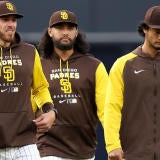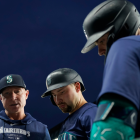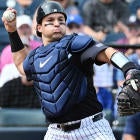Baseball's unpredictability -- the structural parity that so often leads to unexpected outcomes across a game, series, or even season -- is for most fans one of its most enduring charms. For the sports bettor, though, that same defiance of assumptions can be frustrating, or even costly. For those reasons, the "first five innings" MLB lines are quite appealing, as our associates at SportsLine know so well.
The name -- first five innings -- is instructive because that's what you're betting on. If the team you lay money on is winning after five full innings, then you win your bet regardless of how innings six through nine play out. As well, the over/under for the first five is set at roughly half of the full-game O/U.
Obviously, starting pitchers are vital when you bet the first five. This, of course, is the era of ramped-up bullpen usage, and managers are pulling their starters -- often in pre-emptive fashion -- earlier and earlier. This table tells the story:
| Year | MLB innings/start | MLB quality start percentage |
|---|---|---|
2018 | 5.4 | 42 |
2010 | 6.0 | 53 |
2000 | 5.9 | 46 |
1990 | 6.1 | 52 |
1980 | 6.3 | 52 |
1970 | 6.4 | 53 |
You get the general sense of things. Starting pitchers are less important than ever, and by extension teams are more dependent upon their bullpens and the short-run vagaries thereof. With the first five innings, though, you need not be captive to such trends. If you pine for the bygone days of the determinative ace, then the first five is here to help.
For instance, Astros ace Justin Verlander this season has failed to last at least five innings in a start exactly once. Max Scherzer of the Nationals hasn't fallen short of five innings in a start since a playoff tuneup on Sept. 30 of last year. Chris Sale has lasted less than five in just 11 of 203 career starts. You get the idea.
Who should you back in every MLB game, and what teams should you ride all the way to the World Series? Join SportsLine today and get projected scores and stats from 10,000 simulations, plus expert picks, fantasy advice and much more! Use promo code KICKOFF to get your first month for only $1!
As well, it's firmly established that starting pitchers as a species suffer a notable decline when they face a hitter for the third time in a game. This is known as "the times through the order penalty," and it's a genuine phenomenon. The upshot is that pitchers tend to be at their best through the first 18 batters faced of a given game. On that point, it's worth noting that this season pitchers are averaging 21.2 batters faced through the first five innings. In other words, on average they're just dipping their toe into the opposing order for the third time through five innings. That's good news when it comes to a starting pitcher's likelihood to "get at his level" in a five-five bet. When the wheels come off for a starter, it's generally in the sixth inning or later, which is why so many managers aren't letting them get that far these days.
This isn't to say that laying money on those guys will prove a winning play every time, but it is to that your success or lack of same will probably ride on that game's starting pitcher. Such a singular focus is sharply at odds with what baseball has become and is frankly something many of us miss about today's game.
By extension, the first-five outcome is going to be less dependent upon the bullpen and bench in the form of late-inning pinch-hitters. Given that the first-five moneyline tends to be close to the full-game moneyline and that, as noted, the O/U is about half the full-game O/U, you can also find good opportunities when a frontline starting pitcher is paired with a bad bullpen -- think Jacob deGrom and the Mets, for instance. That's because the moneyline in part reflects the quality of the bullpen, even though it generally doesn't come into play in the five five innings. Thus, the first-five bettor has a compelling opportunity under those not-too-uncommon circumstances.
"Those prices are based upon the starting pitching rating and the team rating," explains SportsLine analyst Micah Roberts, "and the team rating includes the bullpen, the lineup, and everything else."
As for the O/U, here are some notable numbers from the 2018 season:
- In innings one thru five, teams are averaging 4.51 runs combined.
- In innings six through nine, teams are averaging 4.44 runs combined.
On a rate basis, run scoring tends to drop in the later innings, but for our purposes there's an opportunity here. The five-inning O/U tends to treat those first five frames as the halfway point, even though it's not, except in the cases of extra-inning affairs (high-level mathematics forthcoming: five is more than half of nine). As such, betting the over in the first five often means getting better value than betting the over for an entire game if you're leaning to a high-scoring affair.
As for Thursday's slate, this scribe likes the first-five O/U under of 5.0 in the Brewers - Reds game. Great American Ballpark in Cincy is a power-hitter's haven, and the Brewers -- with their 175 home runs on the season and counting -- should be ready to hit against Reds starter Cody Reed. As for the Reds, they've been one of the NL's best-hitting teams against lefties this season, and Wade Miley starts for Milwaukee. It says here that they'll combine for more than five runs through the first five innings.
On an entirely different level, playing the first five means less of a time investment for the bettor. "Some people I know," says Roberts, "are just like, 'I don't want to watch the whole game.' It's shorter action, and you don't have to sweat the end."
Given all the hand-wringing over the run-time and pacing of contemporary MLB games -- justified or not -- this qualifies as another selling point.
So if you're disinclined to think of baseball as a bettor's sport, then perhaps the first-five approach will inspire to look at the game with fresh eyes. As with all other flavors of sports betting, SportsLine can help you find the relevant edge.






















